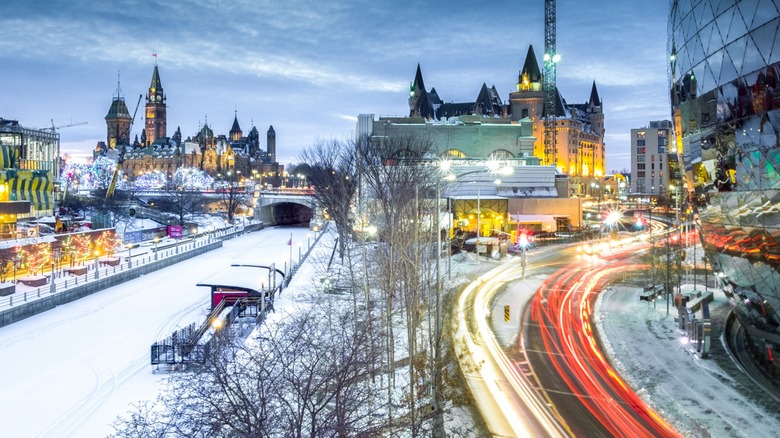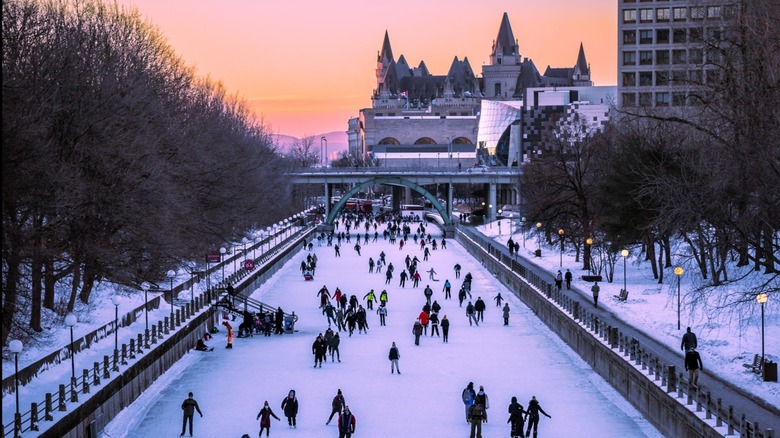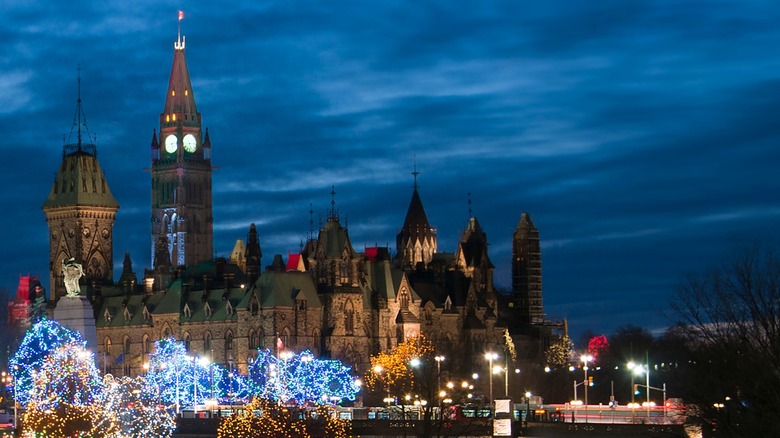Glide Across Canada's Winter Wonderland On The World's Largest Natural Ice Skating Rink
Ice skating might be one of those nostalgic winter activities you partake in as an adult to bring back happy childhood memories — of gliding around a rink with your friends, of stopping to warm up with a cup of hot chocolate, and of listening to that Mariah Carey classic blaring out through the speakers above. But did you know that it can also be a valid form of transport during the coldest winter months in some places?
Canada's vibrant and historical capital, Ottawa, is one such place. Indeed, many people associate Canada with long, frigid winters, and as a place to spot polar bears and view the spectacular northern lights phenomenon — so it likely comes as no surprise that its capital city is home to the largest naturally-frozen ice rink in the world, as designated by the Guinness World Records. The Rideau Canal Skateway, which transforms this city-center canal into a sleek and skate-able surface, is roughly 4.8-miles (7.8-kilometers) long. It starts (or ends) from the locks between the Parliament building and the Fairmont Château Laurier (a grand castle turned luxury hotel), continuing on through Dows Lake and finishing at the Hartwells Locks by Carleton University. Because the skateway winds through Ottawa's downtown core and passes the city's second-largest university, it is not uncommon to see locals zipping down the canal on their way to school or work.
If you haven't already tried it, then a visit to Ottawa this winter is a must — as long as you can brave the cold. Pack up your skates (although rentals are available), gloves, and warm clothing, and explore a beautiful capital city with old-world charm in a unique way: On ice.
The Rideau Canal, past and present
More than a scenic skating path, the Rideau Canal holds much significance, both to the original Indigenous settlers and those who came after. The Algonquin people who lived near the Rideau River called it "Pasapkedjiwanong," which means "river that passes between the rocks". It was used by the Algonquin and other native groups as a travel route between the Ottawa River and Lake Ontario.
The canal was initially constructed for military purposes in the 19th century. After the War of 1812, the British received word that there might be an American invasion of their Upper Canada colony, and this canal was conceptualized as a way to protect the supply line between Montréal and Kingston. The construction occurred between 1826 and 1832 by British engineers under the guidance of Lieutenant-Colonel John By. Around a thousand people (both workers and their family members) died during these six years, mostly from diseases such as malaria and accidents. Yet, despite the loss of life and exorbitant cost (£822,804, which would be worth roughly $148 million today), the expected invasion never came — and, since the canal's completion, there have been no military conflicts between Canada and the United States.
Today's Rideau River usage is quite removed from its past — as a travel route for the Algonquin and a source of protection for the British. Nowadays, the area in and around the canal is a tourist hotspot due to its central location in the city and the natural beauty that surrounds it. Biking along the canal pathways, along with taking eco-friendly cruises, fishing, kayaking, and stand-up paddleboarding in the river, are popular summer activities. And, of course, the canal turns into a magical winter wonderland when it freezes.
Planning your winter visit to Ottawa
The skateway opens once the ice has reached 30 centimeters (12 inches) in thickness, for safety. This means that the dates differ every year, although it usually runs between late January and early March. If you're currently planning a trip, arrange to visit sometime in February — this way, you'll also be in the city for Winterlude, a celebration that takes place on the first three weekends of February. Enjoy immaculate ice sculptures carved by artists, live music, and other entertainment. Kids in particular will love the Snowflake Kingdom, a wintry playground with fun, family-friendly activities.
While the skateway is operational, you can use it 24/7 and reach it by walking or by O-Train (Ottawa's light-rail, rapid-transit system). There are multiple entry points to the rink, as well as five universal access ramps and five rest areas along the route. Three locations offer equipment rentals, including skates, sleighs, and tricycles, with skate-sharpening services available.
During your visit, go for at least one night skate. There will be fewer people, and gliding across the moonlit ice with only stars overhead is simply magical. Try a BeaverTails pastry from one of the rest areas. These Canadian classics are well-worth the hype: Decadently-decorated, whole-wheat pastries served with your choice of toppings, including cinnamon, fruit, and chocolate hazelnut spread. Remember to stop for pictures, and make sure to get that iconic shot of the Fairmont Château Laurier, (hopefully) covered in snow with its turrets rising high above the bridges.
If you'd like to explore beyond Ottawa, Gatineau and Montréal, both in the neighboring province of Québec, are excellent choices. Montréal (2.5 hours away) in particular will charm you with its Paris vibes and great foodie culture.


